CoreMedia’s New KIO AI Promises the ‘Biggest Leap’ in CMS Productivity in Decades

The DXP’s AI “powerhouse” aims to transform how brands manage content, personalize experiences, and engage with customers through a dynamic suite of automation capabilities. Interview with CoreMedia CEO Sören Stamer.
I didn’t have a chance to ask Sören Stamer what the three letters in KIO (pronounced “kee-yo”) stand for – and I quite prefer it that way. It leaves the acronym completely open to my imagination.
Could it be “Knowledge In Overdrive?”
Maybe “Key Intelligence Orchestrator?” What about “Keep It Optimized?”
It’s a long shot, but I’m banking on “Kick-a** Intelligence Operator.”
The truth will be revealed in due course, but if KIO represents anything, it’s a quantum leap forward for CoreMedia. The digital experience platform just unveiled the new solution today, calling it an “AI powerhouse” that promises to transform how brands manage content, personalize experiences, and engage with customers.
As CEO of CoreMedia, Sören is piloting this new suite of AI capabilities, which reflects close collaboration with customers and users. In our recent conversation, he emphasized how the tech is absolutely dynamite, but the people quotient is what really matters – and he sees CoreMedia as the platform for realizing that potential.
“I think one of the big bets we’re making is that the customer experience of the future will be unified,” he explained. “Not just the digital parts. Not just the website, apps, and the like, but the human interaction – the human touch that will also be integrated into this one unified customer experience.”
I’ve been talking to CMS and DXP leaders about their AI features since the end of 2022, and had the – what do I call it, good fortune? – to witness the evolution of the tools and the narrative. In those early pioneering days of the GenAI Wild West, we saw a plethora of simple crash-and-grab integrations with ChatGPT, powering content capabilities that seemed quite impressive at the time.
Then came rapid parity, followed by third-party apps that offered just-like-me features. Heck, we even saw WYSIWYG tools provide the same generative features, thus deprecating the need to build features from scratch. In many ways, it all got kind of, well… commoditized.
Since then, we’ve begun a precipitous slide down the Trough of Disillusionment, with enterprises broadly demanding more concrete value from their AI investments. At the same time, AI governance has taken on a new imperative as organizations wrestle with the risks and rewards. Given all these factors (and then some), CMS and DXP vendors have been considering where artificial intelligence can have the most profound, high-utility impact on automation and scale.
And this is precisely where CoreMedia KIO is endeavoring to establish its value. It seamlessly connects data with content and omnichannel engagement to automate processes at every stage – from analyzing vast data sets to delivering tailored digital experiences and empowering call agents with real-time insights (you know, things humans can’t do at scale).
One of KIO's standout benefits is its intuitive conversational interface, which delivers unprecedented control for users and transforms the workflow experience. As CoreMedia sees it, KIO represents the biggest leap in CMS productivity in decades.
Is that claim itself a leap?
It’s too early to tell. But Sören thinks it’s the real deal.
“AI is transforming businesses by removing operational friction at an unprecedented scale,” he said. “By freeing employees up from routine tasks, they become more productive and can focus on meaningful customer interactions. With the launch of CoreMedia KIO, we’re excited to push the limits of productivity, customer experience, and omnichannel engagement with the world’s leading brands. Through innovative AI-driven automation, we are paving the way for hyper-personalized experiences that truly make a difference.”
To be frank, things change on a daily basis – just check out Hugging Face. Over the last year, I’ve seen a staggering number of innovative AI advancements come online (I’m a big fan of what ai12z is doing), but CoreMedia has been patient, deliberate, and methodical around their strategy. And that could pay off in the long run.
The key to starting KIO
Founded in 1996 in Hamburg, Germany, CoreMedia is the quintessential definition of a legacy platform. Sören, one of its original founders, led the company to profitable growth and international expansion during its first 13 years. After a hiatus, he retook the helm in 2015, just as the drift towards headless and composable was heating up.
The term legacy is often a double-edged sword that cuts deep, and can be an inhibitor to platforms that have grown, shall we say, “long in the tooth.” Add to that a penchant for some practitioners to select hot-shot startups, and older players can struggle against the whitewater. But in the case of well-regarded enterprise vendors with a continuous cycle of innovation, a strong legacy often translates into a safety net for security, governance, and industry best practices. It also reflects a banked currency of wisdom that early-stage startups don’t possess.
CoreMedia has always proven its value to marketing teams, particularly in the realm of online retailers. Global brands like HOKA, Vans, and T-Mobile leverage CoreMedia’s full breadth of digital experience capabilities – including personalization tools – to power “inspirational commerce.”
“I think one of the big bets we’re making is that the customer experience of the future will be unified. Not just the digital parts. Not just the website, apps, and the like, but the human interaction – the human touch that will also be integrated into this one unified customer experience.”
A central part of CoreMedia’s stack is its Content Cloud CMS, which offers high-impact omnichannel engagement tools. These features empower marketers to bring their ideas to life quickly while optimizing every digital touchpoint across every channel, market, and audience. CoreMedia’s DXP has also embraced a composable posture, enabling seamless integration with existing tech stacks and allowing for faster implementation.
From an AI perspective, CoreMedia has long evangelized the breadth and impact of AI-powered personalization. To that end, the company has invested steadily in the right tooling to expand its platform capabilities. This includes the strategic acquisition of BySide and Smarkio in August of 2023, which elevated its ability to craft, manage, and optimize digital experiences and drive more innovation around automation and artificial intelligence.
I asked Sören about CoreMedia’s journey to KIO and what drove the general vector. As he shared, he and his team uncovered a few truths when pursuing the next wave of their AI solution.
“What we saw in the market is that the desire for the customer experience is not what people achieve – and we wondered, why?” he said. “You would like to have a much more personalized experience for customers, more ability to create unique experiences that are relevant for them, where you really excel at addressing and fixing the problem as quickly as possible. Why wasn't that resolved many years ago? One reason we saw was the friction for business users – for the marketers to set these things up, to connect content with data, and to have the right profiles. But also to have the right content for all the different target audiences, and then manage all the different systems to make it work.”
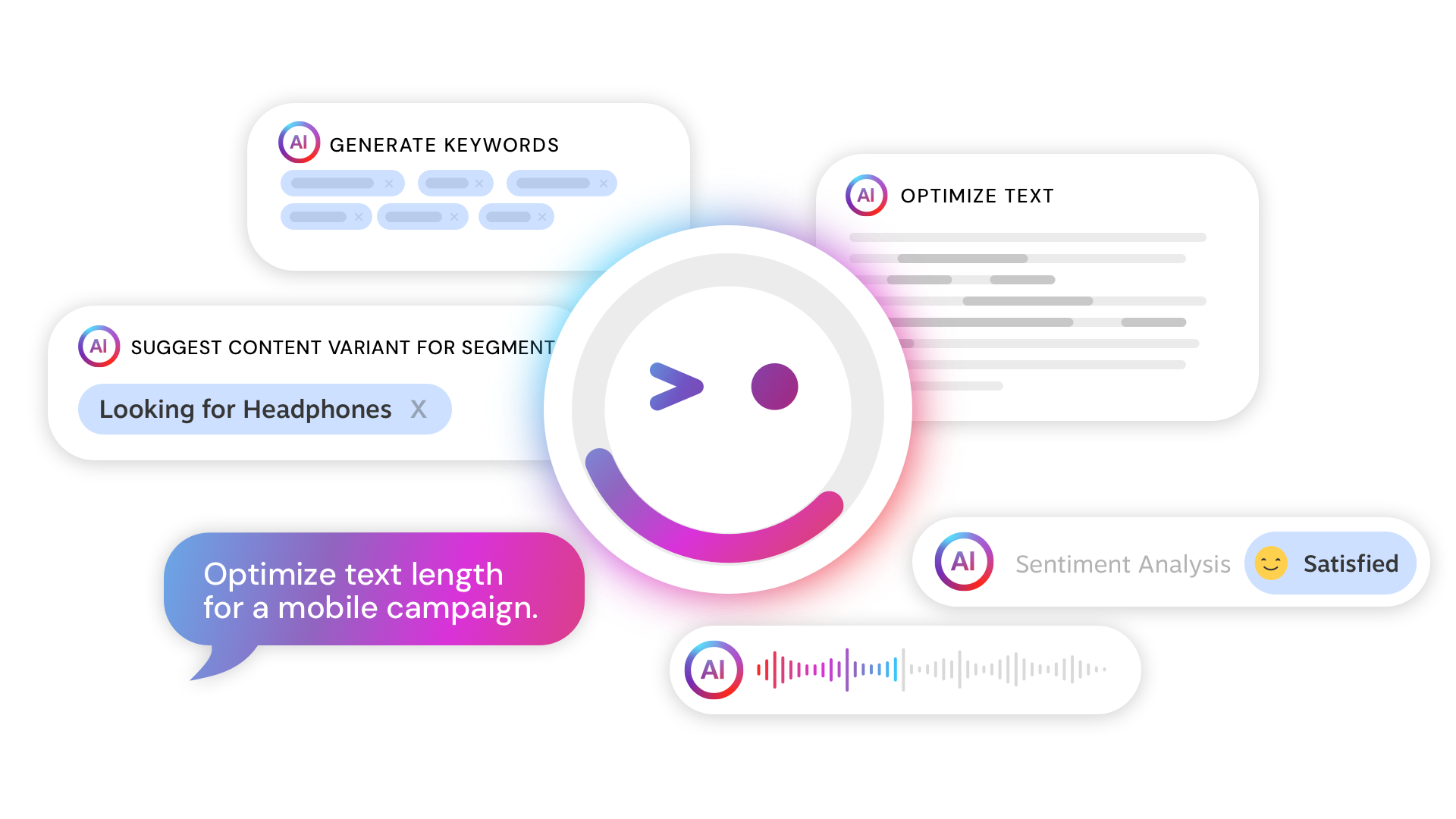
CoreMedia KIO AI is reducing friction for business and marketing users with an array of capabilities
As Sören detailed, CoreMedia saw an opportunity to remove this friction and wholesale improve the customer experience. By reducing these challenges and delighting customers, brands could reduce the propensity for delivering bad (poor? terrible?) experiences – and that became a starting point for the force-multiplying impacts of artificial intelligence and mitigating the challenges of executing in practice.
“Now, if we use AI, we can massively reduce the friction between setting things up and running things,” he explained. “We can automate so much stuff and create a much better experience by using AI as a copilot for the business users. And that’s how we got to KIO.”
Amplifying efficiency with an intelligent assistant
One of the gems in CoreMedia’s AI crown is the new KIO Co-Pilot, a built-in assistant that provides suggestions, personalizes content, and streamlines complex workflows. It allows marketers to create more engaging content for multiple channels and audiences faster while streamlining the setup and delivery.
From a productivity standpoint, this is one of the “big leap” moments from the early days of generative AI to a more promising realm of automation.
“The first iteration with nearly every CMS vendor was let's add large language models and generate more text, or use it to generate images – and that hasn't been too successful,” Sören said. “[Users] want to give it access to, for example, the definition of their brand, the tone of voice, the segments they’re targeting. They also want to give it performance data and content. But then, you know, what is your marketing campaign? When you can add that, the large language model suddenly becomes much more powerful.”
What Sören zeroed in on was automated content operations – a critical part of KIO’s value proposition. Equipped with the right context, it handles everything from the creation of metadata and summaries to tone or length adjustments for various channels and personas. After user approval (humans are still in the loop), it automatically populates all the essential fields, reducing manual input and speeding up workflows.
Along with its core content ops automation, KIO also provides image recognition and processing to help find relevant images and manage mundane and repetitive tasks like suggesting labels, categories, and metadata – as well as setting focal points, cropping images for different channels, and identifying duplicate images. The net result: increased usability, enhanced accessibility, and improved search performance.
KIO’s conversational interface is a slick part of the overall AI package. The intuitive chat experience promises to transform how users interact with CoreMedia’s Experience Platform, allowing them to ask CoreMedia KIO to perform tasks while staying in control.
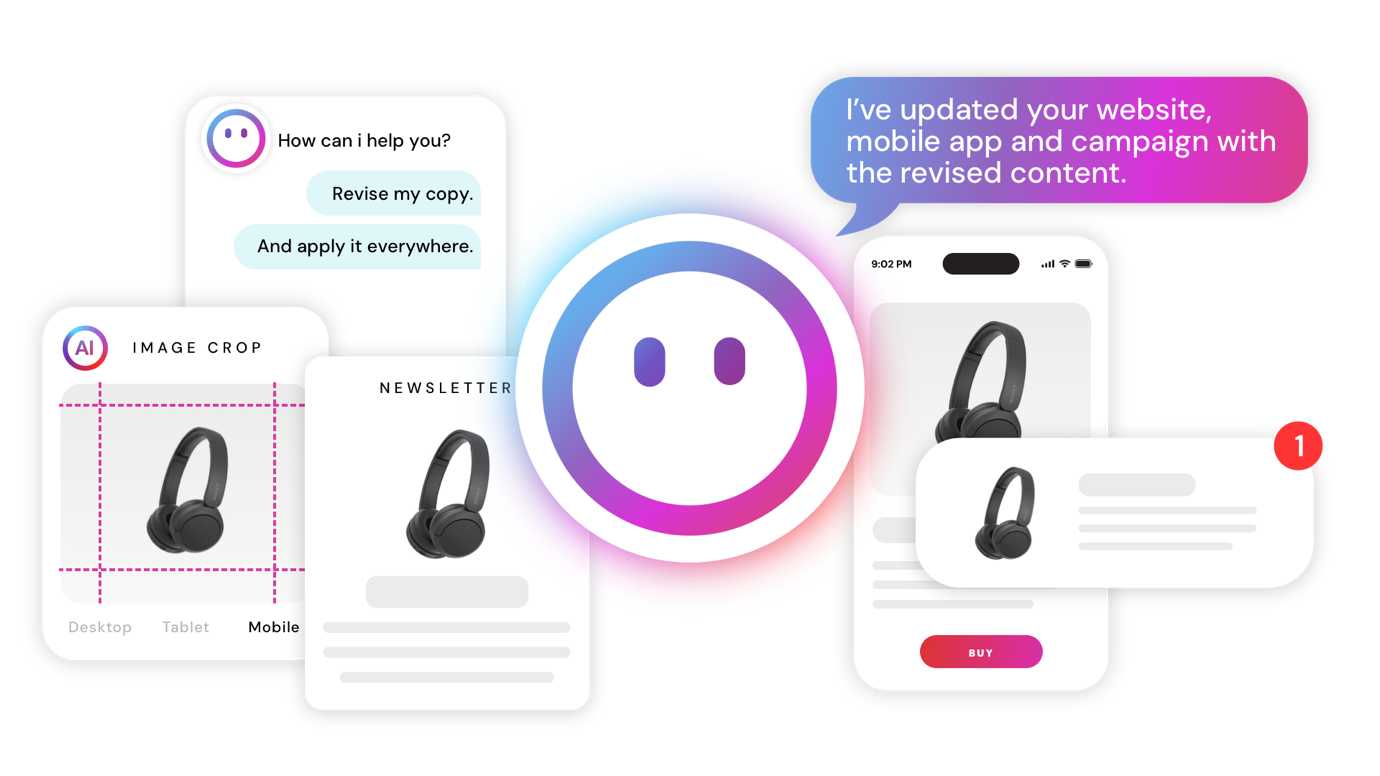
CoreMedia KIO offers a conversational interface that transforms user engagement
By optimizing content quality and speed to market at the same time, brands can potentially achieve higher engagement, improve SEO performance, and elevate the overall impact from their content marketing – faster than ever.
“So this was actually, I think, the more powerful part of large language models,” Sören explained.
Search is another area where KIO is upping the game, making it easy to locate assets within the CoreMedia Experience Platform. You can dig into past content campaigns, find images or articles, and get instant, relevant results. With its AI attributes, KIO helps mitigate the need for multiple filters and click-through lists of legacy content. For example, you can simply ask KIO, “Show the last holiday campaign” and it provides relevant results instantly.
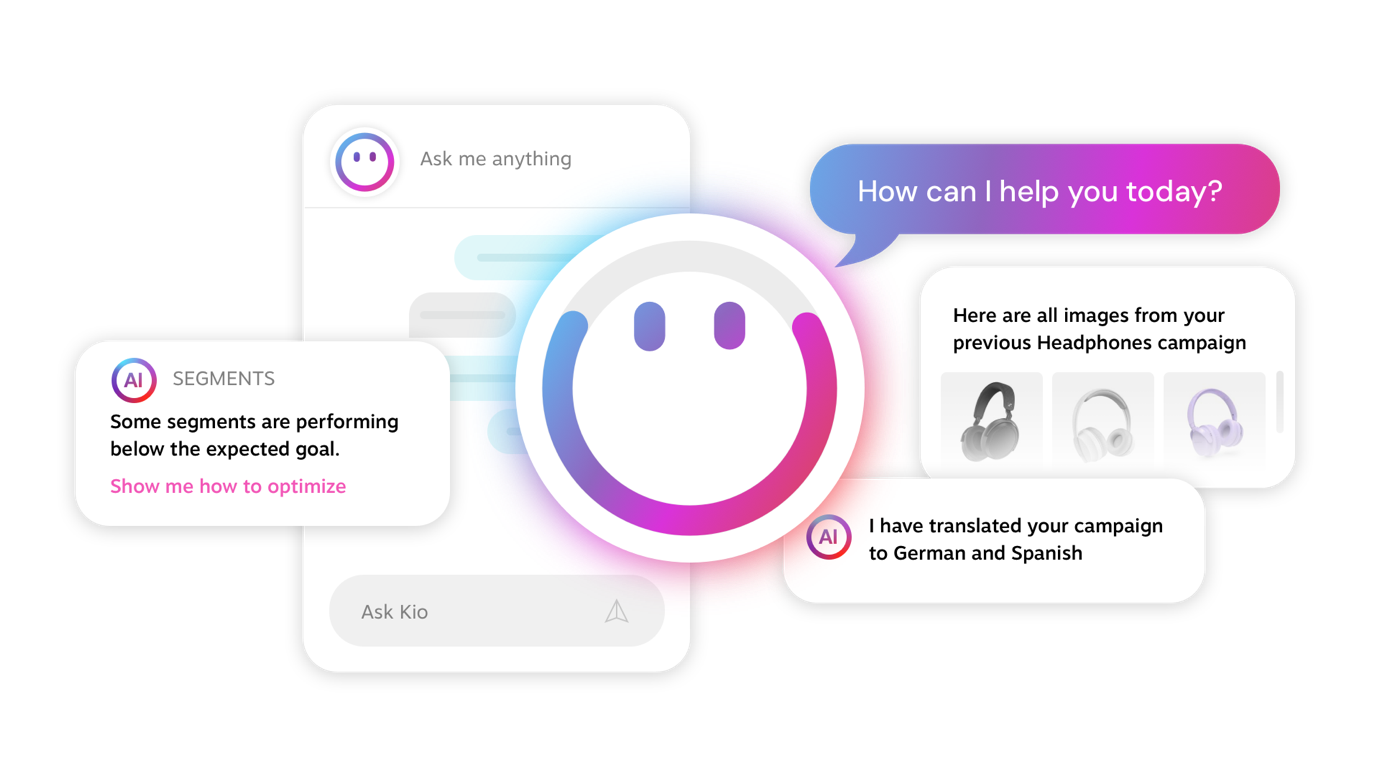
CoreMedia KIO's conversational interface makes search a snap
Given these advancements with conversational AI, KIO is also trimming the timeline to productivity. CoreMedia claims that there’s no need for lengthy manuals or documentation, as KIO Co-Pilot takes you through a series of foundational primers with onboarding questions like “how do I set up a localization workflow?” Users can simply interact with the AI for guidance on how to navigate and utilize the platform.
Making AI personalization easy and conversion-centric
AI-driven analytics is another big promise of KIO, giving businesses more detailed insights into customer behavior, preferences, and trends – all without the need for manual data analysis. By crunching large data sets and making the results more actionable, marketers can better leverage these insights to fuel their personalization strategies. And with its intuitive conversational interface, users can effortlessly access these metrics without digging through endless reports.
Historically, one of the biggest barriers to scalable personalization has been the ability to test content variations. KIO helps streamline this by utilizing extensive audience data to create tailored content variants based on segments – and mapping the most relevant content to high-value audiences.
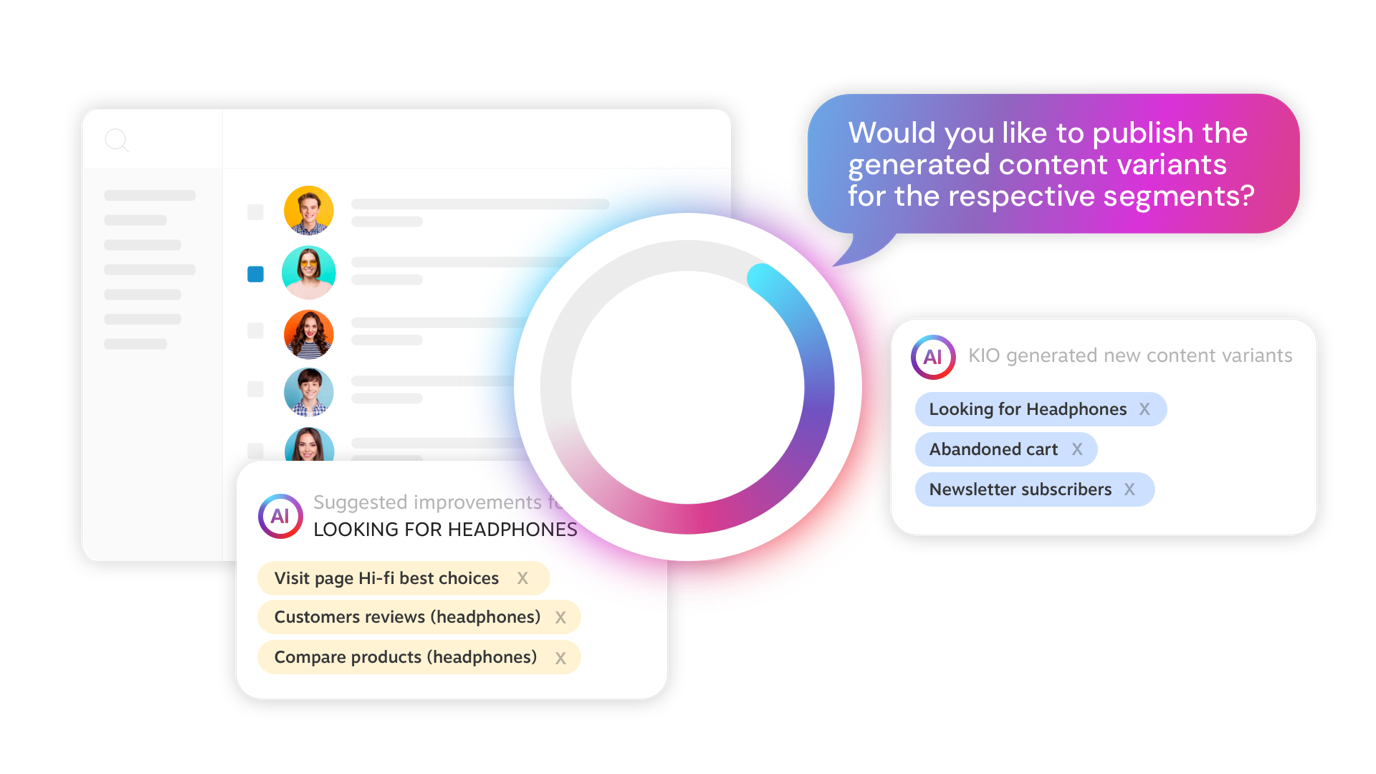
CoreMedia KIO can streamline content variants for personalization with its conversational interface
The benefits are clear: by automating the delivery of the right recommendations and content to the right customer at the right time, CoreMedia KIO can help strengthen customer intimacy and tailor every interaction – which can elevate conversions, retention rates, and overall customer satisfaction.
Real time AI-powered support
It’s cool that CoreMedia is tackling call and chat support as part of its AI strategy. Most enterprises rely on humans as part of these critical workflows – particularly when (insert expletive) hits the fan. While IVRs and chatbots can handle the elemental connections with AI and automation, many customers require escalation. And that’s where people get the job done.
Still, live call and chat practitioners can leverage AI to further enhance their direct experiences. With CoreMedia’s Operator Assistant, agents now have instant access to customer preferences, sentiment analysis, and AI-driven response suggestions during customer interactions. Having this information at their fingertips – delivered through an interactive chat interface – equips agents with “superpowers” to effectively personalize responses and assist customers faster and more effectively.
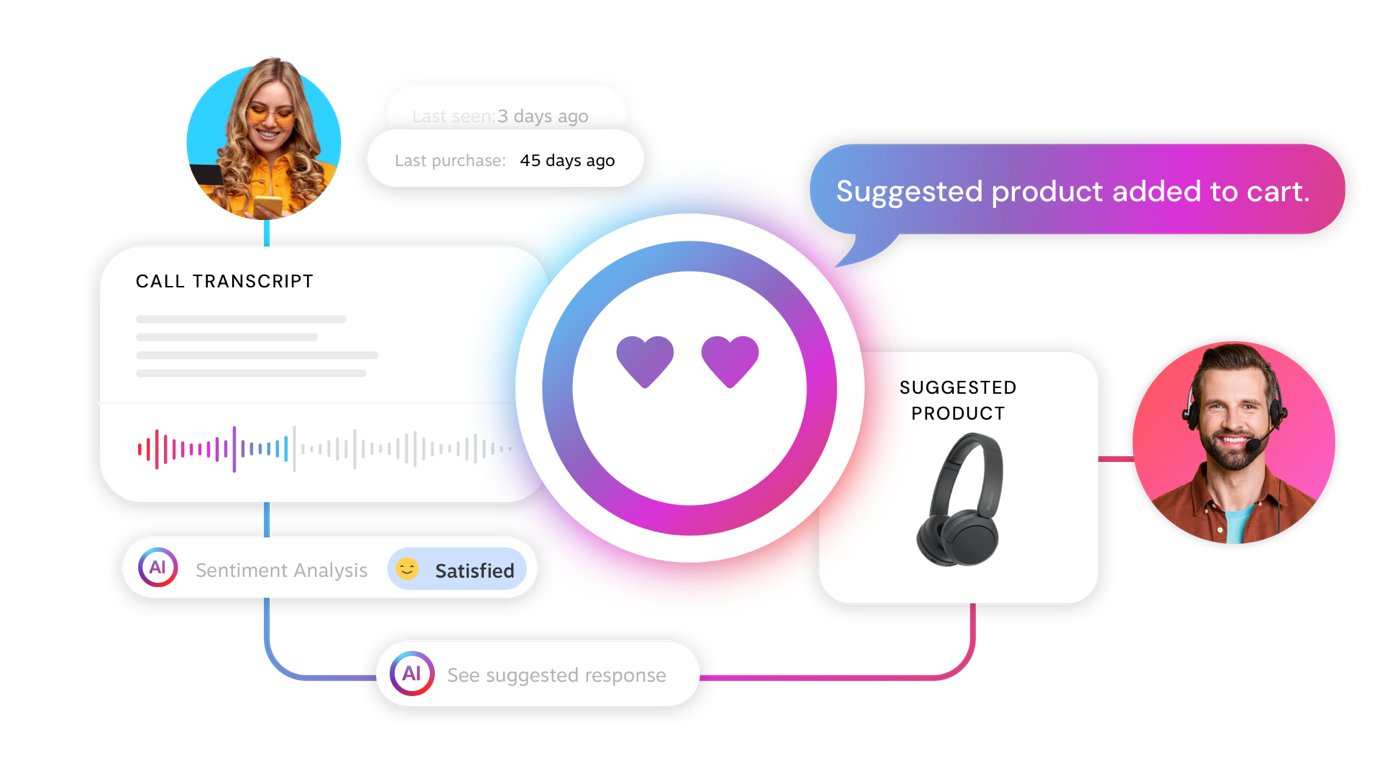
With Optimal Response Suggestions, CoreMedia KIO can provide sentiment analysis and responses to agents
CoreMedia’s Optimal Response Suggestions utilizes KIO for historical data, customer preferences, and real-time behavior to recommend the best responses during phone calls, video shopping sessions, or live chats, supporting agents to help customers faster with a tailored approach. There’s also automated speech-to-text call transcription that makes it easier for agents to search, analyze, and act on call data – all without manual input.
CoreMedia KIO can also capture customer sentiment in real time, allowing agents to adjust their approach to a frustrated customer and deliver more empathetic interactions to help increase satisfaction. By reducing average handling time, KIO enables agents to focus on complex issues that require human expertise to maximize customer satisfaction.
Focusing on composability, security, and flexibility
What does it mean to be “composable” in 2025? It’s a bit of a loaded question, and traditional DXP vendors certainly have a different opinion from modern headless CMSes. And yet, both embrace a centrist reality that the customer wants everything. Hence why we’ve seen the emergence of a “Universal CMS” concept.
I asked Sören about his perspective on this. CoreMedia does, after all, position itself as a “composable DXP,” just like Sitecore and Contentstack. So where are the distinctions?
“The one downside of composability is you suddenly have a different complexity to management,” he said. “So you have, indeed, to make sure that the different components you put together – and potentially even different contracts and different vendors – all stays up to date and in a working fashion. So there’s a liberal trade-off, and what we see is that AI and large language models can be very powerful in managing this, acting like the glue between different systems.”
There are certainly other positive tenets of composability that legacy DXPs have been embracing, but it’s novel to hear that AI could be a solution to the problem of managing complex systems – thus enabling more of the tacit, MACH-centric architectures as well as the integrations that DXPs are capable of managing.
Along with these architectural fundamentals, CoreMedia is enabling a great deal of flexibility in its posture, starting with cloud agnosticism. KIO is designed to run on any cloud platform, adhering to the highest security standards and data privacy regulations – which are of central concern when deploying any AI solution. KIO can also be deployed in private cloud environments and on-premises.
Further reflecting its innate flexibility, CoreMedia KIO has been designed to work seamlessly with any LLM, giving businesses the freedom to use their LLM of choice. This includes OpenAI, Azure OpenAI, Anthropic Claude, or even custom models.
From a productivity perspective, users can easily customize their workflows without the need for coding or development resources with KIO’s AI Playbooks. This is a great asset, as users can direct KIO to perform complex tasks via its conversational interface. There’s also a seamless integration with CoreMedia Studio.
Why it matters
The scope and impact of AI is simply undeniable. The early gains with LLMs were impressive, but now, we’re seeing more examples of how AI innovation is translating into tangible productivity gains for CMS and DXP platform users – and making a real impact.
While CoreMedia KIO offers a robust, integrated AI solution within a comprehensive DXP, there are still significant challenges around the policy and control of these technologies – some of which the platform addresses. I drilled deeper into this with Sören (vis-à-vis "governance"), and he’s optimistic that AI can help solve some of its own challenges.
“This governance topic, I think, will also be done massively with AI itself,” he said. “We add a lot of metadata [to websites], and we want to know things like when it was edited, and by whom. But with AI, we also want to know what large language model was used and when – even which version – to make sure that we’re able to confirm that everything has been edited with the same model. Or maybe we want to use a new model now because we know there were some issues with [the original]. So you need governance at the higher level overall.”
With KIO, CoreMedia has embraced the mantle of being an “AI-first Experience Platform.” The company has clearly strategized around how these features can impact customers, and in commercial industries where e-commerce carries the day, speed to market can determine success or failure. Providing a dynamic, conversational AI solution that bridges the chasms between DXP capabilities is a smart move, and could have profound impacts on productivity.
It's worth noting that CoreMedia KIO is currently open for trial to all CoreMedia customers running on V12 (24.06). According to the company’s press release, leading brands are already using its AI capabilities to transform how users interact with their CMS to meet the challenges of complexity and experience orchestration – and even drive ROI. You can request a free demo here.
Will KIO present a truly differentiated value for CoreMedia in an increasingly competitive market of like-solutions? It’s hard to say, particularly when the noise level around AI features from other CMS and DXP platforms is increasing. That said, the conversational interface and integrated capabilities offer great potential and deserve close consideration if you’re looking at a future platform migration.
I’m still not sure what KIO stands for. But if Sören’s outlook is any indicator, it might just be “Keep It Optimistic.”
Looking for guidance on CoreMedia? Talk to us.
Upcoming Events

CMS Kickoff 2025
January 14-15, 2025 – Tampa Bay Area, Florida
Join us next January in the Tampa Bay area of Florida for the third annual CMS Kickoff – the industry's premier global event. Similar to a traditional kickoff, we reflect on recent trends and share stories from the frontlines. Additionally, we will delve into the current happenings and shed light on the future. Prepare for an unparalleled in-person CMS conference experience that will equip you to move things forward. This is an exclusive event – space is limited, so secure your tickets today.

CMS Summit 25
May 13-14, 2025 – Frankfurt, Germany
Don't miss the first European edition of our prestigious international conference dedicated to the global content management community! CMS Summit 25 will bring together top-notch speakers, our renowned learning format, and engaging social events. Hear from leading practitioners like Deutsche Bahn, Dr. Oetker, and more – and join customers, agencies, and CMS vendors as we discuss current trends and what's ahead for the content and digital experience fields. Connect and network at the only vendor-neutral, in-person conference focused on CMS. Space is limited for this exclusive event, so book your seats today.